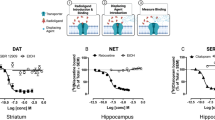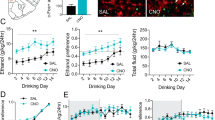Abstract
Adenosine is an important mediator of ethanol intoxication. In vitro, ethanol stimulates adenosine signaling by inhibiting the type 1 equilibrative nucleoside transporter (ENT1), whereas chronic ethanol exposure downregulates ENT1. It is not known, however, whether ENT1 is important for ethanol intoxication or consumption in vivo. Here we report that ENT1-null mice show reduced hypnotic and ataxic responses to ethanol and greater consumption of alcohol as compared with their wild-type littermates. These features are associated with a decrease in adenosine tone, as measured indirectly as a reduction in A1 receptor–mediated inhibition of glutamate excitatory postsynaptic currents (EPSCs) in the nucleus accumbens, leading to increased phosphorylation of CRE-binding protein (CREB) in the striatum. Treatment with an A1 receptor agonist decreases EPSC amplitude and reduces ethanol consumption in ENT1-null mice. Our results indicate that ENT1 has a physiological role in ethanol-mediated behaviors and suggest that decreased A1 adenosine receptor function promotes alcohol consumption.
This is a preview of subscription content, access via your institution
Access options
Subscribe to this journal
Receive 12 print issues and online access
$209.00 per year
only $17.42 per issue
Buy this article
- Purchase on Springer Link
- Instant access to full article PDF
Prices may be subject to local taxes which are calculated during checkout






Similar content being viewed by others
References
Dunwiddie, T.V. & Masino, S.A. The role and regulation of adenosine in the central nervous system. Annu. Rev. Neurosci. 24, 31–55 (2001).
Dar, M.S. Mouse cerebellar adenosinergic modulation of ethanol-induced motor incoordination: possible involvement of cAMP. Brain Res. 749, 263–274 (1997).
Dar, M.S. Modulation of ethanol-induced motor incoordination by mouse striatal A1 adenosinergic receptor. Brain Res. Bull. 55, 513–520 (2001).
Carmichael, F.J. et al. Central nervous system effects of acetate: contribution to the central effects of ethanol. J. Pharmacol. Exp. Ther. 259, 403–408 (1991).
Nagy, L.E. et al. Adenosine is required for ethanol-induced heterologous desensitization. Mol. Pharmacol. 36, 744–748 (1989).
Nagy, L.E., Diamond, I., Casso, D.J., Franklin, C. & Gordon, A.S. Ethanol increases extracellular adenosine by inhibiting adenosine uptake via the nucleoside transporter. J. Biol. Chem. 265, 1946–1951 (1990).
Sanderson, G. & Scholfield, C.N. Effects of adenosine uptake blockers and adenosine on evoked potentials of guinea-pig olfactory cortex. Pflugers Arch. 406, 25–30 (1986).
Diao, L. & Dunwiddie, T.V. Interactions between ethanol, endogenous adenosine and adenosine uptake in hippocampal brain slices. J. Pharmacol. Exp. Ther. 278, 542–546 (1996).
Geiger, J.D. & Nagy, J.I. Heterogeneous distribution of adenosine transport sites labelled by [3H]nitrobenzylthioinosine in rat brain: an autoradiographic and membrane binding study. Brain Res. Bull. 13, 657–666 (1984).
Anderson, C.M. et al. Distribution of equilibrative, nitrobenzylthioinosine-sensitive nucleoside transporters (ENT1) in brain. J. Neurochem. 73, 867–873 (1999).
Li, T.K., Lumeng, L. & Doolittle, D.P. Selective breeding for alcohol preference and associated responses. Behav. Genet. 23, 163–170 (1993).
Bowers, B.J. Applications of transgenic and knockout mice in alcohol research. Alcohol Res. Health 24, 175–184 (2000).
Crabbe, J.C. et al. Elevated alcohol consumption in null mutant mice lacking 5-HT1B serotonin receptors. Nat. Genet. 14, 98–101 (1996).
Jennings, L.L. et al. Distinct regional distribution of human equilibrative nucleoside transporter proteins 1 and 2 (hENT1 and hENT2) in the central nervous system. Neuropharmacology 40, 722–731 (2001).
Harvey, J. & Lacey, M.G. A postsynaptic interaction between dopamine D1 and NMDA receptors promotes presynaptic inhibition in the rat nucleus accumbens via adenosine release. J. Neurosci. 17, 5271–5280 (1997).
Carlezon, W.A. Jr. et al. Regulation of cocaine reward by CREB. Science 282, 2272–2275 (1998).
Lonze, B.E. & Ginty, D.D. Function and regulation of CREB family transcription factors in the nervous system. Neuron 35, 605–623 (2002).
Svenningsson, P. et al. Involvement of striatal and extrastriatal DARPP-32 in biochemical and behavioral effects of fluoxetine (Prozac). Proc. Natl. Acad. Sci. USA 99, 3182–3187 (2002).
Florio, C., Prezioso, A., Papaioannou, A. & Vertua, R. Adenosine A1 receptors modulate anxiety in CD1 mice. Psychopharmacology 136, 311–319 (1998).
El Yacoubi, M., Ledent, C., Parmentier, M., Costentin, J. & Vaugeois, J.M. The anxiogenic-like effect of caffeine in two experimental procedures measuring anxiety in the mouse is not shared by selective A2A adenosine receptor antagonists. Psychopharmacology 148, 153–163 (2000).
Marston, H.M. et al. Pharmacological characterization of a simple behavioral response mediated selectively by central adenosine A1 receptors, using in vivo and in vitro techniques. J. Pharmacol. Exp. Ther. 285, 1023–1030 (1998).
Self, D.W. et al. Involvement of cAMP-dependent protein kinase in the nucleus accumbens in cocaine self-administration and relapse of cocaine-seeking behavior. J. Neurosci. 18, 1848–1859 (1998).
Barrot, M. et al. CREB activity in the nucleus accumbens shell controls gating of behavioral responses to emotional stimuli. Proc. Natl. Acad. Sci. USA 99, 11435–11440 (2002).
Shaw-Lutchman, T.Z., Impey, S., Storm, D. & Nestler, E.J. Regulation of CRE-mediated transcription in mouse brain by amphetamine. Synapse 48, 10–17 (2003).
Walters, C.L. & Blendy, J.A. Different requirements for cAMP response element binding protein in positive and negative reinforcing properties of drugs of abuse. J. Neurosci. 21, 9438–9444 (2001).
Nestler, E.J. Molecular basis of long-term plasticity underlying addiction. Nat. Rev. Neurosci. 2, 119–128 (2001).
Scholz, K.P. & Miller, R.J. Inhibition of quantal transmitter release in the absence of calcium influx by a G protein-linked adenosine receptor at hippocampal synapses. Neuron 8, 1139–1150 (1992).
Scanziani, M., Capogna, M., Gahwiler, B.H. & Thompson, S.M. Presynaptic inhibition of miniature excitatory synaptic currents by baclofen and adenosine in the hippocampus. Neuron 9, 919–927 (1992).
Wu, L-G. & Saggua, P. Adenosine inhibits evoked synaptic transmission primarily by reducing presynaptic calcium influx in area CA1 of hippocampus. Neuron 12, 1139–1148 (1994).
Backstrom, P., Bachteler, D., Koch, S., Hyytia, P. & Spanagel, R. mGluR5 antagonist MPEP reduces ethanol-seeking and relapse behavior. Neuropsychopharmacology 29, 921–928 (2004).
Backstrom, P. & Hyytia, P. Ionotropic glutamate receptor antagonists modulate cue-induced reinstatement of ethanol-seeking behavior. Alcohol Clin. Exp. Res. 28, 558–565 (2004).
Ballarin, M., Fredholm, B.B., Ambrosio, S. & Mahy, N. Extracellular levels of adenosine and its metabolites in the striatum of awake rats: inhibition of uptake and metabolism. Acta Physiol. Scand. 142, 97–103 (1991).
Nagel, J. & Hauber, W. Effects of salient environmental stimuli on extracellular adenosine levels in the rat nucleus accumbens measured by in vivo microdialysis. Behav. Brain Res. 134, 485–492 (2002).
Baldwin, S.A., Mackey, J.R., Cass, C.E. & Young, J.D. Nucleoside transporters: molecular biology and implications for therapeutic development. Mol. Med. Today 5, 216–224 (1999).
Naassila, M., Ledent, C. & Daoust, M. Low ethanol sensitivity and increased ethanol consumption in mice lacking adenosine A2A receptors. J. Neurosci. 22, 10487–10493 (2002).
Svenningsson, P., Le Moine, C., Fisone, G. & Fredholm, B.B. Distribution, biochemistry and function of striatal adenosine A2A receptors. Prog. Neurobiol. 59, 355–396 (1999).
Schuckit, M.A. Biological, psychological and environmental predictors of the alcoholism risk: a longitudinal study. J. Stud. Alcohol 59, 485–494 (1998).
Choi, D.S., Wang, D., Dadgar, J., Chang, W.S. & Messing, R.O. Conditional rescue of protein kinase Cε regulates ethanol preference and hypnotic sensitivity in adult mice. J. Neurosci. 22, 9905–9911 (2002).
Hodge, C.W. et al. Supersensitivity to allosteric GABAA receptor modulators and alcohol in mice lacking PKCε. Nat. Neurosci. 2, 997–1002 (1999).
Acknowledgements
We are grateful to S. Taylor and J. Connolly for technical support. This work was supported by funds provided by the State of California for medical research on alcohol and substance abuse through the University of California at San Francisco, and by the National Institute on Alcohol Abuse and Alcoholism (grant AA013588 to R.O.M.).
Author information
Authors and Affiliations
Corresponding author
Ethics declarations
Competing interests
The authors declare no competing financial interests.
Supplementary information
Rights and permissions
About this article
Cite this article
Choi, DS., Cascini, MG., Mailliard, W. et al. The type 1 equilibrative nucleoside transporter regulates ethanol intoxication and preference. Nat Neurosci 7, 855–861 (2004). https://doi.org/10.1038/nn1288
Received:
Accepted:
Published:
Issue Date:
DOI: https://doi.org/10.1038/nn1288
This article is cited by
-
Stiffness and axial pain are associated with the progression of calcification in a mouse model of diffuse idiopathic skeletal hyperostosis
Arthritis Research & Therapy (2023)
-
Anticonvulsant Role of Adenosine is Blunted During Alcohol Withdrawal Syndrome in an Adult Zebrafish Model
Neurochemical Research (2023)
-
In vivo phenotypic validation of adenosine receptor-dependent activity of non-adenosine drugs
Purinergic Signalling (2023)
-
Apoptotic brown adipocytes enhance energy expenditure via extracellular inosine
Nature (2022)
-
N6-substituated adenosine analog J4 attenuates anxiety-like behaviors in mice
Psychopharmacology (2022)



